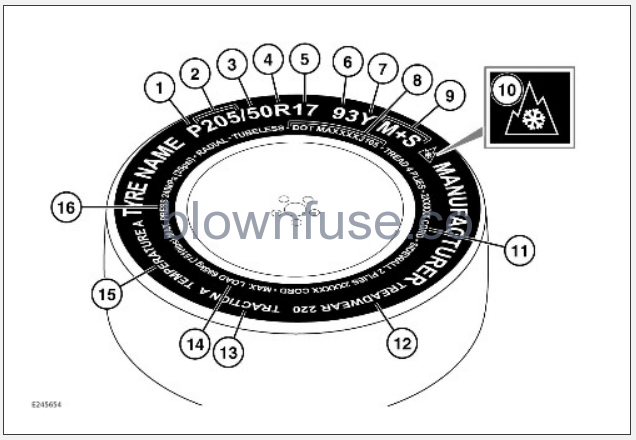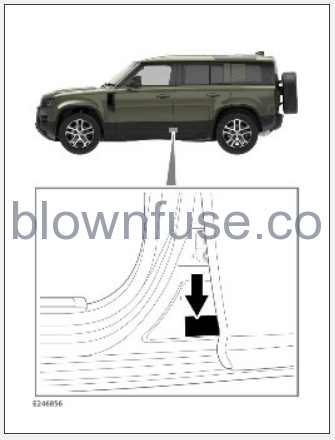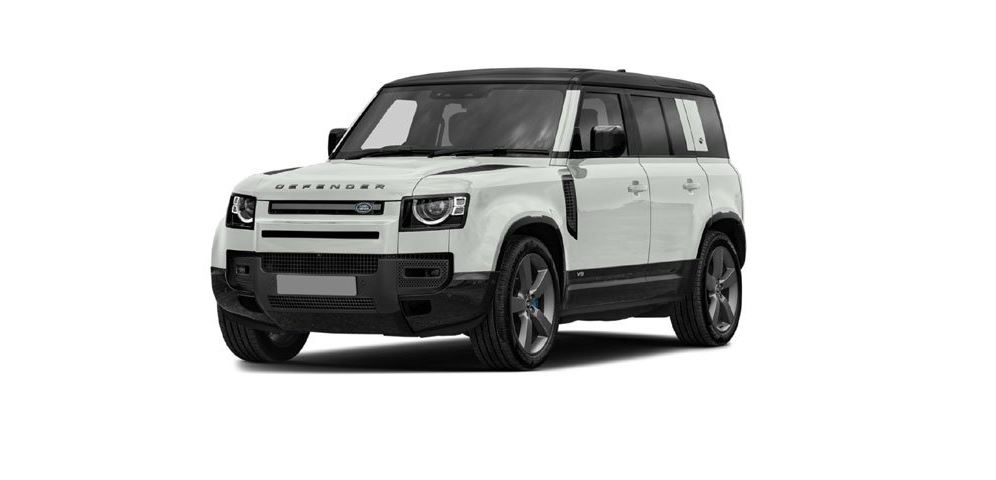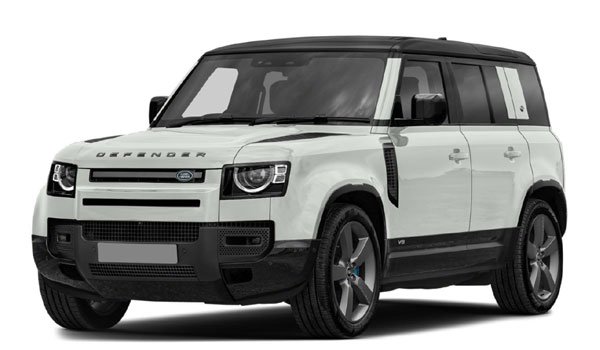 2023 Land Rover Defender TIRES
2023 Land Rover Defender TIRES
TYRE MARKINGS

Make sure the relevant safety warnings have been read and understood before replacing a tyre. See REPLACEMENT TYRES.
All replacement tyres must be the same specification as the original equipment tyres, except for approved winter tyres, off-road tyres, and Professional Off-Road (POR) tyres. If in doubt, consult a retailer/authorised repairer. Failing to comply with these rules can lead to accidents, potentially causing serious injury or death.
- P indicates that the tyre is for passenger vehicle use. The index is not always shown.
NOTES
Some vehicles might be equipped with high load (HL) tyres. High load capacity is marked with HL at location 1, before the tyre size. HL tyres have higher load capacity than extra load (XL) tyres. - The width of the tyre from sidewall edge to sidewall edge, given in mm.
- The aspect ratio, also known as the profile, gives the sidewall height as a percentage of the tread width. For example, if the tread width is 205 mm and the aspect ratio is 50, the sidewall height is 102 mm.
- R indicates that the tyre is of radial ply construction.
- The diameter of the wheel rim, given in inches.
- The load index for the tyre. The load index specifies the maximum load the tyre can carry at the speed indicated by the tyre’s speed rating. The index is not always shown.
- The speed rating denotes the maximum speed at which the tyre may be used for extended periods. See SPEED RATING.
- Tyre manufacturing standard information, which can be used for tyre identification for recalls and other checking processes. This information relates to the manufacturer, place of manufacture, etc. The last four numbers are the date of manufacture. For example, if the number is 3119, the tyre was made in the 31st week of 2019.
- M+S or M/S indicates that the tyre is designed with some capability for mud and snow.
- The winter tyres symbol identifies dedicated winter tyres. See USING WINTER TYRES.
- The number of plies in both the tread area and the sidewall area. The number of plies indicates how many layers of rubber-coated material make up the structure of the tyre. Information is also provided on the type of materials used.
- Wear rate indicator: E.g., a tyre rated at 400 lasts longer than a tyre rated at 200.
- The traction rating grades a tyre’s performance when stopping on a wet road surface. The higher the grade, the better the braking performance. The grades, from highest to lowest, are: AA, A, B, and C.
NOTES
The traction grade assigned to the tyre is based on straight-ahead braking traction tests and does not include acceleration, cornering, hydroplaning, or peak traction characteristics. - The maximum load which can be carried by the tyre.
- Heat resistance grading: The tyre’s resistance to heat is grade A, B, or C, with A indicating the greatest resistance to heat. The grading is provided for a correctly inflated tyre which is being used within its speed and loading limits.
- The maximum inflation pressure for the tyre. The maximum inflation pressure should not be used for normal driving. See AVOIDING FLAT SPOTS.
Approved tyres are identified by the brand mark J, LR, or J LR. Brand markings are specifically excluded for winter and POR tyres.
SPEED RATING
| Rating | Speed km/h (mph) |
|---|---|
| Q | 160 (99) |
| R | 170 (106) |
| S | 180 (112) |
| T | 190 (118) |
| U | 200 (124) |
| H | 210 (130) |
| V | 240 (149) |
| W | 270 (168) |
| Y | 300 (186) |
TYRE CARE
Make sure the following warnings have been read and fully understood before driving the vehicle. Failure to do so may result in an accident, potentially leading to serious injury or death.
- Do not drive the vehicle if a tyre is damaged, excessively worn, or incorrectly inflated. A tyre in such a condition may catastrophically fail.
- Avoid contaminating the tyres with vehicle fluids. Vehicle fluids may cause damage to the tyre and cause tyre failure.
- Avoid spinning the wheels. The forces released can damage the structure of the tyre and cause tyre failure.
- If wheel spin is unavoidable due to a loss of traction, e.g., in deep snow, do not exceed the 50 km/h (30 mph) point on the speedometer. Do not allow anyone to stand near or directly behind a tyre that might spin.
- Do not exceed the maximum pressure stated on the sidewall of the tyre.
Tyre condition should be checked after the vehicle has been used off-road. As soon as the vehicle returns to a normal, hard road surface, stop and check for damage to the tyres. Check all the vehicle’s tyres, including the spare, regularly for damage, wear, and distortion. If in any doubt about the condition of a tyre, have it checked immediately by a tyre repair centre or a retailer/authorised repairer.
TYRE PRESSURE SAFETY
Make sure to read and fully understand the following warnings. Failure to comply with the safety instructions could result in an accident, leading to serious injury or death.
- Check the tyres, including the spare, for condition and pressure on a weekly basis and before long journeys.
- All tyre pressures, including the spare, should be checked. Failure to properly maintain the tyre pressures could increase the risk of tyre failure.
- The loading of the vehicle should always be considered when checking and adjusting the tyre pressures. Failure to do so may lead to a loss of control, potentially causing serious injury or death. See TYRE PRESSURE LABEL.
- Always use a calibrated tyre pressure gauge. Using an un-calibrated tyre pressure gauge may result in tyres with incorrect pressures. Incorrect tyre pressure can lead to vehicle instability.
- Never drive the vehicle if the tyre pressures are incorrect. Under-inflation causes excessive flexing and uneven tyre wear, which can lead to sudden tyre failure. Over-inflation causes harsh ride, uneven tyre wear and poor handling.
- Under-inflation also reduces fuel efficiency and tyre tread life and may affect the vehicle’s handling and stopping ability.
- If the tyre pressures are checked while the vehicle is inside a protected, covered area, e.g., a garage, and subsequently driven in lower outdoor temperatures, tyre under-inflation could occur.
- A slight pressure loss occurs naturally with time. If this exceeds 0.14 bar (2 psi, 14 kPa) per week, have the cause investigated and rectified by qualified personnel.
- Pressure checks should be carried out ideally when the tyres are cold, and the vehicle has been stationary for more than 3 hours. A hot tyre at, or below, the recommended cold inflation pressure, is dangerously under-inflated. Tyres can be hot after driving, if the vehicle has been parked in strong sunlight, or used in high ambient temperatures. Do not reduce the tyre pressures. Recheck the pressures when cold.
- If the tyre pressures are checked when the tyres are warm, expect the pressures to have increased by up to 0.3 to 0.4 bar (4 to 6 psi, 30 to 40 kPa). If Tyre Pressure Monitoring System (TPMS) advised pressures are not available in the instrument panel, allow the tyres to cool fully before adjusting the pressures.
For vehicles with TPMS, it is possible to adjust the pressure of a warm tyre, providing the advised pressures are used. See TYRE PRESSURE CHECK.
TYRE PRESSURES
Make sure to read and fully understand the following safety warnings and cautions before checking, and adjusting the tyre pressures. See TYRE PRESSURE SAFETY.
For vehicles with Tyre Pressure Monitoring System (TPMS), inflate the tyres to the advised pressures displayed, in brackets, in the instrument panel. See TYRE PRESSURE CHECK.
Confirm that the TPMS is set for the correct vehicle loading. See VEHICLE LOADING.
When the tyres are cold, inflate to the recommended cold tyre pressures, shown on the tyre pressure label, if:
- TPMS is not fitted to the vehicle.
- The advised tyre pressures are not displayed in the instrument panel.
See TYRE PRESSURE LABEL.
TYRE INFLATION PROCEDURE:
To avoid damaging the valves, do not apply excessive force or sideways pressure on the gauge and/or inflator.
To avoid damage to the TPMS valves, it is recommended not to use rigid tyre inflation wands. Rigid tyre inflation wands increase the risk of excess leverage and sideways pressure on the valve.
The following procedure must be used to adjust the tyre pressures:
- Remove the tyre valve cap.
- Firmly attach a tyre pressure gauge and/or inflator to the valve.
- Read the tyre pressure from the gauge and add air, if required.
- If air is added to the tyre via a manual gauge, remove the gauge and re-attach it before reading the pressure. Failure to do so may result in an inaccurate reading.
NOTES
If the tyre pressure is too high, remove the gauge and press the centre of the valve to allow air out of the tyre. Refit the gauge to the valve and check the pressure. - Refit the valve cap.
TYRE PRESSURE LABEL

The recommended cold inflation tyre pressures are listed on a label in the front door opening, or on a label on the underside of the front door.
The pressures on the label provide optimum ride and handling characteristics for all normal operating conditions.
The label contains the following information:
- Cold inflation pressures for the front, rear, and spare tyres.
- Cold inflation pressures for both vehicle loading conditions.
- A list of the tyres available for all specifications of the vehicle.
The labels must not be changed, even if different wheels and tyres are fitted at a later stage.
TYRE VALVES
Do not twist or bend the tyre valves when attaching a pressure hose or gauge. Doing so may cause damage, leading to tyre failure. Death or serious injury may result.
Keep the tyre valve caps screwed down firmly to prevent water or dirt from entering the valve. Check the valves for leaks when checking the tyre pressures.
Do not use metal valve caps, as these can corrode onto the valve threads and be difficult or impossible to remove.
REPLACEMENT TYRES
Make sure to read and fully understand the following warnings and cautions. Failure to comply with the safety instructions could result in damage to the vehicle, or an accident, leading to serious injury or death.
- Always fit replacement tyres of the same type and, wherever possible, of the same make and tread pattern as the original. Failure to comply may reduce vehicle stability, efficiency, and range.
- The load index and speed ratings on all replacement tyres must be at least the same specification as the vehicle’s original equipment. If in doubt, consult a retailer/authorised repairer.
- If the use of tyres not recommended by the vehicle manufacturer is unavoidable, make sure to read and fully comply with the tyre manufacturer’s instructions. Failure to do so may lead to tyre failure due to incorrect fitting or use.
- Drive within the speed limitations of the tyres, especially if lower speed-rated tyres are fitted, e.g., winter tyres, off-road, or Professional Off-Road (POR) tyres. In markets that require a tyre’s maximum speed label to be fitted, the label should be placed within the driver’s field of vision. Tyre maximum speed labels can be obtained from the tyre retailer. Consult a retailer/authorised repairer for further information.
- Tyre removal and fitting should only be carried out by a retailer/authorised repairer.
Make sure that the Tyre Pressure Monitoring System (TPMS) sensor is not damaged during a tyre change.
Visibility of the rear lights may be compromised if a non-approved spare wheel is fitted to the taildoor. A compromised visibility of the rear lights may lead to accidents, potentially causing serious injury or death.
The spare wheel cover is only designed to fit over the original spare wheel supplied with the vehicle. Attempting to fit the spare wheel cover to a different spare wheel may result in damage to the cover.
If in doubt about the spare wheel fitment, consult a retailer/authorised repairer.
When the tread has worn down to approximately 2 mm, wear indicators start to appear at the surface of the tread pattern. Wear indicators produce a continuous band of rubber across the tread, as a visual reminder.
It is recommended that tyres are replaced in sets of four. If this is not possible, replace the tyres in pairs, both front or both rear. When the tyres are replaced, make sure to have the wheels re-balanced and the alignment checked.
Use the correct tyre specification and pressures. Alternatively, contact a retailer/authorised repairer for advice. See TYRE PRESSURES.
PRESSURE COMPENSATION FOR TEMPERATURE CHANGES
Daily ambient temperature variations may cause intermittent, minor tyre pressure changes, which is normal and should not indicate a tyre failure.
To mitigate this condition, check and adjust the tyre pressures to the recommended cold inflation pressures before vehicle use.
Make sure that the correct tyre pressures are maintained when moving to areas of differing ambient temperature. See TYRE PRESSURES.
AVOIDING FLAT SPOTS
In areas of extended high ambient temperature, vehicle tyres can be affected by a softening of the tyre’s sidewall. If the vehicle is stationary for long periods, the tyre deforms at the point where the standing surface meets the tyre.
The tyre deformation described is known as a flat spot and is normal tyre behaviour.
When the vehicle is subsequently driven, a vibration may be experienced from the flat spot. The condition steadily improves with extra mileage.
In order to minimise flat spotting, increase the tyre pressures to the maximum, as stated on the tyre’s sidewall. The tyres must be returned to the specified running pressures before driving. See TYRE PRESSURES and TYRE MARKINGS.
TYRE DEGRADATION
Tyres degrade over time, due to the effects of ultraviolet light, extreme temperatures, high loads, and environmental conditions. It is recommended that all tyres, including the spare tyre, are replaced at least every 6 years from the date of manufacture. However, the tyres may require replacement more frequently.
USING WINTER TYRES
A dedicated winter tyre often has a lower speed rating than the original equipment tyre. Consequently, the vehicle must be driven within the speed limitation of the winter tyre. Consult a retailer/authorised repairer for further information. In markets that require a tyre’s maximum speed label to be fitted, make sure to place the label within the driver’s field of vision. Maximum speed labels can be obtained from the tyre retailer. Failure to adhere to the winter tyre’s speed limit may result in an accident, potentially leading to serious injury or death.
M+S tyres have a recognised level of winter performance. However, the M+S marking on the sidewall of the tyre does not necessarily indicate that the tyre is a dedicated winter tyre. The M+S marking on an all-season tyre indicates that it is designed for use all year round, including in cold temperatures, snow, and ice. The performance of all-season tyres is generally inferior to a dedicated winter tyre in conditions specific to winter.
In many countries, legislation exists that requires the use of winter tyres during specified periods of the year.
The winter tyres symbol identifies dedicated winter tyres. Dedicated winter tyres are recommended if optimum winter traction is required, or if the vehicle is to be used in more extreme winter conditions.
The tyre pressures indicated on the tyre information label are for use in all conditions on the original equipment tyres. If a reduced speed-rating tyre is fitted, the recommended pressures are only suitable up to the tyre’s maximum speed, with a normal vehicle load. Vehicle speed should be restricted to below 160 km/h (100 mph) when heavily loaded.
Winter tyres must be fitted to all four wheels.
For optimum traction, the tyres should be run-in for at least 160 km on dry roads, before driving on snow or ice.
Use of dedicated winter tyres may require a change of wheel size, depending on the original choice of wheel. All four wheels must be changed.
If the wheels fitted have standard rubber valves, the Tyre Pressure Monitoring System (TPMS) warning lamp flashes for 75 seconds and then remains illuminated.
When the original wheels and tyres are refitted, the vehicle needs to travel a short distance to reset the TPMS and extinguish the warning lamp.
| Recommended winter tyres | |||||
|---|---|---|---|---|---|
| Wheel size | Tyre size | Brand | Pattern | Rim width / Profile / Offset | Type |
| 18 in | 255/70R18 116V | Michelin | Pilot Alpin 5 | 8.0J / CH+ / 41.5 | Alpine |
| 255/70R18 116R | Nokian | Hakkapeliitta R3 SUV | Studless | ||
| 19 in | 255/65R19 114V | Continental | TS 850 P SUV | 8.0J / CH2 / 41.5 | Alpine |
| 20 in | 255/60R20 113V | Pirelli | Scorpion Winter | 8.5J / CH+ / 41.5 | Alpine |
| 275/55R20 117Q | Nokian | Hakkapeliitta R3 SUV | Studless | ||
| 22 in | 275/45R22 112W | Continental | TS 850 P SUV | 9.0J / CH+ / 43.0 | Alpine |
| Michelin | Xice N4 SUV | Studded | |||
Studded tyres are market dependent. If in doubt, or for further information, contact a retailer/authorised repairer. Alternatively, visit: www.ownerinfo.landrover.com.
For information about the latest recommended winter tyres, contact a retailer/authorised repairer. Alternatively, visit: www.ownerinfo.landrover.com.
PROFESSIONAL OFF-ROAD (POR) TYRES
| Recommended Professional Off-Road (POR) tyres | |||||
|---|---|---|---|---|---|
| Wheel size | Tyre size | Brand | Pattern | Rim Width / Profile / Offset | Type |
| 18 in | 255/70R18 116Q | Goodyear | DuraTrac | 8.0J / CH+ / 41.5 | POR |
| 19 in | 255/65R19 114Q | Goodyear | DuraTrac | 8.0J / CH2 / 41.5 | POR |
| 20 in | 255/60R20 113Q | Goodyear | DuraTrac | 8.5J / CH+ / 41.5 | POR |
For information about the latest recommended POR tyres, contact a retailer/authorised repairer. Alternatively, visit: www.ownerinfo.landrover.com.
USING SNOW CHAINS
Make sure the following warnings have been read and fully understood before using snow chains. Failure to use the snow chains safely could result in an accident, leading to serious injury or death.
- Only use traction devices in heavy snow conditions, on compacted snow.
- Dynamic Stability Control (DSC) must be switched off when using traction devices.
- Never exceed 50 km/h (30 mph) when traction devices are fitted.
- Never fit traction devices to a temporary-use spare wheel.
- Traction devices approved by the vehicle manufacturer may be used to improve traction in heavy snow conditions, on compacted snow.
- Traction devices should not be used in off-road conditions where there is no compacted snow.
If it becomes necessary to fit traction devices, the following points must be observed:
- Only use vehicle manufacturer approved traction devices on the vehicle. Only vehicle manufacturer approved traction devices have been tested to make sure that the devices do not cause damage to the vehicle. Contact a retailer/authorised repairer for information.
- The wheels and tyres fitted to the vehicle must conform to the specifications of the vehicle manufacturer’s original equipment. Doing so helps to enhance the performance of the traction devices. See TYRE MARKINGS.
- Full-chain traction devices can be fitted to the front and rear wheels of vehicles with the following tyre sizes:
255/70R18.
255/65R19.
255/60R20.
- Half-chain traction devices can be fitted to the front and rear wheels of vehicles with the following tyre size:
275/45R22.
- Do not fit a traction device to a temporary-use spare wheel.
- Always read, understand, and follow the traction device manufacturer’s instructions. Pay particular attention to the maximum speed and fitting instructions.
- Fit traction devices in pairs on the same axle.
- Remove the traction devices, as soon as the conditions allow, to avoid tyre and/or vehicle damage.
Contact a retailer/authorised repairer for details and availability of approved snow chains.
When using snow chains, select the grass gravel snow driving program and switch DSC off. See GRASS GRAVEL SNOW and SWITCHING DYNAMIC STABILITY CONTROL (DSC) OFF.
TYRE DECLARATION (INDIA ONLY)
All imported tyres meet the requirements of Bureau of India Standards (BIS) and comply with the requirements under Central Motor Vehicle Rules (CMVR) 1989. The tyres are the same as those tyres supplied as original equipment for Land Rover models which are fully Type Approved for the Indian market.

